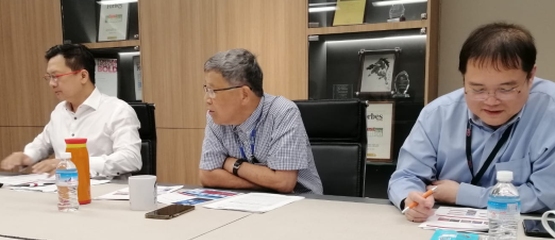Excerpts from CGS-CIMB report
Analyst: Cezzane See
| Covid-19 and low crude oil prices; priced in ■ We think value in CSE is emerging as it now trades below its 2014-19 average 12M forward mean, and closer to trough of 7.9x P/E in Dec 2018.
■ We think the risk-reward ratio is favourable at current levels. Reiterate Add, with a lower TP of S$0.45, now based on 11x CY21F EPS.FY19 core net profit of S$25.0m was ahead at 111%/109% of our/consensus FY19F estimates (S$22.5m/S$22.8m). Final DPS of 1.5Scts was announced. |
||||
 FY19 results conference call (L-R): CFO Eddie Foo | Non-executive Chairman Lim Ming Seong | MD Lim Boon Kheng. Photo by Ngo Yit Sung
FY19 results conference call (L-R): CFO Eddie Foo | Non-executive Chairman Lim Ming Seong | MD Lim Boon Kheng. Photo by Ngo Yit Sung
| Back at 2014 crude oil crisis valuations |
|
Priced in |
|
|
CSE currently trades at c.8.6x FY21F P/E, below its 2014-2019 average 12M forward mean of 11.9x P/E.
In a bear scenario, it could trade at S$0.31; close to its trough valuation of 7.9x in Dec 2018 when Singapore stock market sentiment was weak on fears that the US-China trade war would blow up, in our view.
| Value emerging; reiterate Add |
We reiterate Add on CSE with a lower target price of S$0.45, now based on 11x CY21F EPS, close to 5-year (2014-2019) average of 11.9x; this implies a favourable risk-reward of at least a c.28% upside vs. a downside of 7%, or S$0.32/share (assuming we apply FY19’s trough of 7.9x on FY21F EPS), if sentiment worsens in the near term.
Its c.8% dividend yield is an added bonus.
Potential re-rating catalysts are swifter project execution and higher order wins (thus potential revenues).
Downside risks are lower order wins and potential cut in DPS.
| Order book stronger now than in 2008; and even 2015 |
We liken CSE’s current situation to the last crude oil price crisis (in 2014-2016) instead of the Global Financial Crisis (GFC) in 2009 as post several acquisitions in 2016-2019, CSE now sees more onshore work (shale) and Australian communications businesses -- both less cyclical than offshore oil and gas projects, in our view.
The other silver lining is a higher end-FY19 order backlog of S$307.9m vs. end-FY08 order backlog of S$212.7m (non-healthcare).
This end-FY19 order backlog is also higher vs. its end-FY15 order book of S$192m, putting it on a more solid footing, in our view.
| Raise FY20-21F forecasts |
We raise our FY20-21F revenue forecasts by 5.0-5.9% given the high order backlog and as we expect flow contracts to grow sustainably.
We also raise our finance costs as we think they were too low previously and lower our tax expense (in lieu of the lower effective tax) assumptions.
Overall, our FY20-21F EPS forecasts increase by 4.3-5.4%. We also introduce FY22F EPS which features net profit growth of 1.3%.
| Lower FY20-22F EPS on capex cuts and delayed project executions |
| Several oil/gas players have begun guiding for lower capex/opex plans, at least for 2020F. Covid-19 resulted in various levels of movement restrictions implemented in several countries, including CSE’s major markets, the US, Australia, and Singapore. In 2014-2016, CSE’s order wins fell c.20% yoy, even dipping to S$60m in one quarter. The current movement controls could result in slower project execution on CSE's order book. We cut FY20-22F EPS due to lower order expectations of S$280m-420m for FY20-22F (vs. c.S$480m-530m previously) |
Full report here





